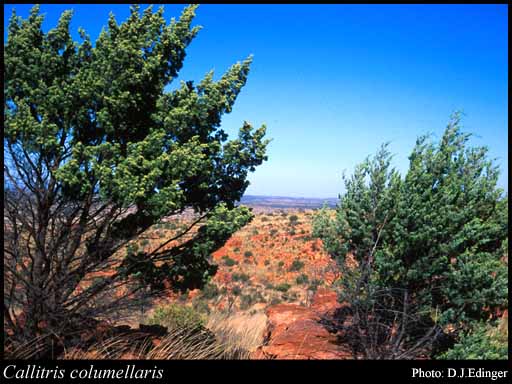- Reference
- Fragm. (Mueller) 5:198 (1865)
- Conservation Code
- Not threatened
- Naturalised Status
- Mixed (Native in Part of Range, Naturalised Elsewhere)
- Name Status
- Current
Erect tree, to 7.6 m high, foliage blue-green, bark rough, fissured or fibrous, grey. Red or yellow sand, red, brown, grey or yellow clay or sandy loam, grey gypsum, gravel, ironstone, laterite, granite, quartzite. Sandplains, hill slopes and summits, valleys, on cliffs, scree slopes and breakaways, around salt lakes.

Distribution
- IBRA Regions
- Avon Wheatbelt, Central Kimberley, Central Ranges, Coolgardie, Gascoyne, Geraldton Sandplains, Gibson Desert, Great Victoria Desert, Jarrah Forest, Little Sandy Desert, Mallee, Murchison, Northern Kimberley, Pilbara, Swan Coastal Plain, Victoria Bonaparte, Yalgoo.
- IBRA Subregions
- Augustus, Berkeley, Carnegie, Central, Chichester, Eastern Goldfield, Eastern Mallee, Eastern Murchison, Edel, Geraldton Hills, Hamersley, Katanning, Keep, Lateritic Plain, Mann-Musgrave Block, Mardabilla, Merredin, Mitchell, Mount Eliza, Northern Jarrah Forest, Pentecost, Perth, Shield, Southern Cross, Tallering, Trainor, Western Mallee, Western Murchison.
- IMCRA Regions
- Kimberley.
- Local Government Areas (LGAs)
- Ashburton, Coolgardie, Corrigin, Cuballing, Dalwallinu, Derby-West Kimberley, Dundas, East Pilbara, Esperance, Greater Geraldton, Halls Creek, Kalgoorlie-Boulder, Kondinin, Koorda, Kulin, Lake Grace, Laverton, Leonora, Meekatharra, Menzies, Merredin, Mount Magnet, Mount Marshall, Mukinbudin, Mundaring, Murchison, Murray, Narembeen, Ngaanyatjarraku, Northampton, Nungarin, Perenjori, Sandstone, Shark Bay, Upper Gascoyne, Westonia, Wiluna, Wyndham-East Kimberley, Yalgoo, Yilgarn.
Management Notes (for the Swan NRM Region)
General Biology. Growth form. Tree. Reproduction. Seed. Dispersal. Wind, water. Time to first flowering. 6-8 years. Vegetative regeneration strategy. Produces root suckers. Woody structure. Non-porous. Seedbank persistence. Short, days-1 year. Fire response. Hot fire kills mature plants. Seed is released from the canopy and germinates rapidly in the post fire environment.
Additional information. Origin. Eastern Australia. History of use/introduction. Garden escape.
Suggested method of management and control. Apply 250 ml Access® in 15 L of diesel to basal 50 cm of trunk (basal bark) or cut and paint with 100% glyphosate. Stem injection in this species may be ineffective due to non-porous wood. Read the manufacturers' labels and material safety data sheets before using herbicides. For further information consult the Australian Pesticides and Veterinary Medicines Authority to determine the status of permits for your situation or state.
Management Calendar
| Calendar Type | Jan | Feb | Mar | Apr | May | Jun | Jul | Aug | Sep | Oct | Nov | Dec | Comments |
|---|---|---|---|---|---|---|---|---|---|---|---|---|---|
| Fruiting | Y | O | Y | Y | |||||||||
| Germination | Y | Y | Y | Y | Y | Y | |||||||
| Optimum Treatment | Y | Y | Y | Y | Y | Y | Y | Y | Y | Y | Y | Y |
Legend: Y = Yes, regularly, O = Occasionally, U = Uncertain, referred by others but not confirmed.
References
- Brown, K. & Brooks, K. (2002) Bushland Weeds: A Practical Guide to their Management. Environmental Weeds Action Network, Greenwood.
- Clayton-Greene, K.A. & Ashton, D.H. (1990) The dynamics of Callitris columellaris/Eucalyptus albens communities along the Snowy River and its tributaries in south-eastern Australia. Australian Journal of Botany, 38: 403-432.
- Hussey, B.M.J., Keighery, G.J., Dodd, J., Lloyd, S.G. & Cousens, R.D. (2007) Western Weeds. A guide to the weeds of Western Australia. 2nd Edition. The Plant Protection Society of Western Australia, Victoria Park.